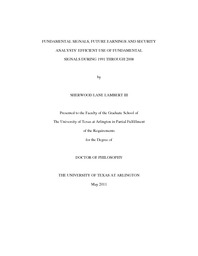
ATTENTION: The works hosted here are being migrated to a new repository that will consolidate resources, improve discoverability, and better show UTA's research impact on the global community. We will update authors as the migration progresses. Please see MavMatrix for more information.
Show simple item record
| dc.contributor.author | Lambert, Sherwood Lane | en_US |
| dc.date.accessioned | 2011-07-14T20:53:55Z | |
| dc.date.available | 2011-07-14T20:53:55Z | |
| dc.date.issued | 2011-07-14 | |
| dc.date.submitted | January 2011 | en_US |
| dc.identifier.other | DISS-11079 | en_US |
| dc.identifier.uri | http://hdl.handle.net/10106/5838 | |
| dc.description.abstract | This dissertation builds upon one of the foundation articles in Fundamental Analysis, written by Abarbanell and Bushee [1997] (AB-97), that studied the relationship of fundamental signals (combinations of items reported in the financial statements) to future accounting earnings during 1983-1990. Guided by fundamental financial and managerial/cost accounting concepts, this study adds fundamental signals to the AB-97 earning-signals model. The added fundamental signals include proxies for operating leverage, market share, markup, and total manufacturing costs. A revised ("Experimental") long-term growth variable is introduced that allows for negative EPS (loss) values in the geometric mean growth rate computation. The expanded model is used to analyze the earnings-relevance of the studied fundamental signals during 1991-2008, and the results for each of the AB-97 signals as well as each of the added signals are evaluated. The AB-97 methodology for analyzing security analysts' efficient use of the fundamental signals is modified to express utilization efficiency as a percent, and analysts' actual forecast error rates are computed and compared to the analysts' utilization percents. The results include the finding that the operating leverage proxy is a consistently significant and important predictor of long-term growth, giving rise to the recommendation that GAAP requires firms to report an estimate of their annual total fixed costs, or at least that manufacturing firms report their total annual manufacturing overhead costs. Hierarchical regression results indicate that the added fundamental signals provide significant incremental explanatory/predictive power above that provided by the AB-97 fundamental signals that were based on the guidance of security analysts. Also, the results provide marginal support for analysts' efficient use of the fundamental signals in making their one-year-ahead EPS forecast revisions having increased after EDGAR in 1996 and after Regulation FD in 2000. | en_US |
| dc.description.sponsorship | Taylor, Martin | en_US |
| dc.language.iso | en | en_US |
| dc.publisher | Accounting | en_US |
| dc.title | Fundamental Signals, Future Earnings And Security Analysts' Efficient Use Of Fundamental Signals During 1991 Through 2008 | en_US |
| dc.type | Ph.D. | en_US |
| dc.contributor.committeeChair | Taylor, Martin | en_US |
| dc.degree.department | Accounting | en_US |
| dc.degree.discipline | Accounting | en_US |
| dc.degree.grantor | University of Texas at Arlington | en_US |
| dc.degree.level | doctoral | en_US |
| dc.degree.name | Ph.D. | en_US |
Files in this item
- Name:
- Lambert_uta_2502D_11079.pdf
- Size:
- 934.3Kb
- Format:
- PDF
This item appears in the following Collection(s)
Show simple item record


